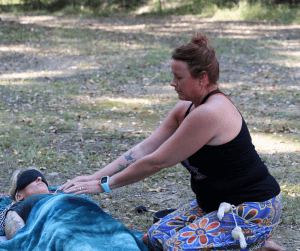Using the Breath in Massage
Breathing is an essential part of life that we often take for granted. However, in massage therapy, the breath can be a tool to enhance the relaxation and healing process for clients. By incorporating proper breathing techniques into massage therapy, therapists can help clients release tension, increase circulation, and achieve a deeper state of relaxation.
The Benefits of Breath
Breathing is a powerful tool that can help clients release tension and achieve a deeper state of relaxation. Proper breathing helps to increase oxygen flow to the body’s tissues, which can increase circulation and promote healing. In addition, deep breathing can help to release endorphins, which are the body’s natural painkillers.
Breath Awareness
Before beginning a massage, it is important to help clients become aware of their breath. Many people hold their breath or breathe shallowly when they are stressed or anxious. By helping clients focus on their breath, therapists can help them relax and release tension.
Breathing Techniques
There are several breathing techniques that therapists can use during a massage. One technique is to instruct clients to take a deep breath in, hold it for a few seconds, and then exhale slowly. This technique can help clients release tension in their muscles and achieve a deeper state of relaxation.
Another technique is to instruct clients to breathe in rhythm with the massage strokes. For example, during a Swedish massage, clients can breathe in as the therapist strokes up the body and exhale as the therapist strokes down the body. This technique can help clients synchronize their breath with the massage, which can enhance the relaxation process.
Breath Awareness during Stretching
Breathing can also be used during stretching. Instructing clients to inhale as they stretch and exhale as they release the stretch can help them relax and release tension. This technique can also help clients achieve a greater range of motion during stretching.
Conclusion
Incorporating proper breathing techniques into massage therapy can help clients release tension, increase circulation, and achieve a deeper state of relaxation. By helping clients become aware of their breath and teaching them breathing techniques, therapists can enhance the healing process for their clients. learn the techniques and become a qualified breathwork practitioner.
1. Deep breathing: Encourage your client to take deep breaths in through the nose and out through the mouth. This helps to slow down the heart rate, reduce stress, and improve oxygen flow to the body.
2. Diaphragmatic breathing: Ask your client to place one hand on their chest and the other on their belly. Instruct them to take deep breaths in through the nose, feeling the belly expand, and then exhale slowly through the mouth, feeling the belly contract. This technique helps to activate the diaphragm muscle and increase relaxation.
3. Box breathing: This technique involves inhaling for a count of four, holding the breath for a count of four, exhaling for a count of four, and holding the breath for a count of four. Repeat this cycle for several minutes to calm the mind and body.
4. Alternate nostril breathing: This technique involves closing one nostril and inhaling through the other, then closing that nostril and exhaling through the opposite nostril. Repeat this cycle several times to balance the energy in the body and calm the mind.
Remember to always check with your client before incorporating breathwork techniques into a massage therapy session, and to adjust the techniques based on their comfort level.
Join our nalu breathwork tribe





